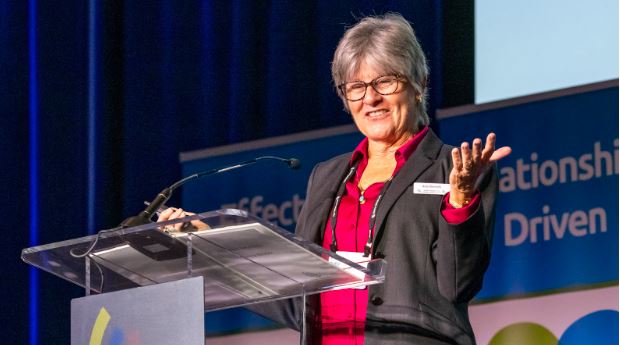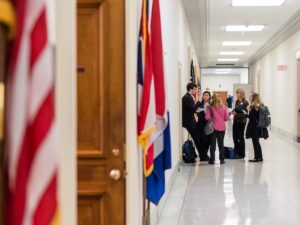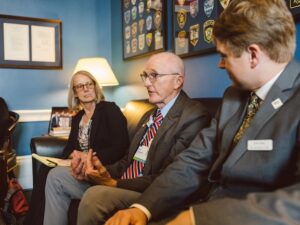By Steve Valk
After more than a dozen years on staff, Amy Bennett, Director of Congressional Liaisons and Lobby Days for Citizens’ Climate Lobby, is retiring. During her tenure, CCL grew from an unknown grassroots organization with less than a dozen chapters to one of the most admired and respected advocacy groups working on climate change, with 550 chapters worldwide. She hands the reins over to Kesten Bozinovic, who started out as one of Amy’s interns a decade ago.
For thousands of concerned citizens who wanted to create the political will to solve climate change but didn’t know where to start, Amy was the sherpa guiding them up the path that led to engaging their members of Congress. She trained volunteers to organize and hold effective meetings with congressional offices and to navigate the labyrinthian process of scheduling a lobby meeting. And when CCL brought volunteers to Washington for conferences and lobbying, it was Amy who oversaw the daunting task of organizing and scheduling teams to meet with as many offices as possible. On one lobby day, CCL managed to conduct meetings with over 500 out of 535 offices, a feat that astounded other advocacy organizations.
I recently had the opportunity to talk to Amy about her time with CCL. Here is some of that conversation.
What were you doing before you started working with CCL?
I worked at an animal care facility in Southern California called Helen Woodbridge Animal Center, which was really cool because I love animals, and it was working with both people and animals. That’s where I got my start with volunteer management. I started volunteering there. They said, “Hey, you look kind of organized. Why don’t you run the volunteer program?” It was so rewarding to see people helping animals and animals helping people.
How did you learn about CCL, and what prompted you to get involved?
The more I understood [about climate change], the more I understood that this wasn’t just gonna hurt people. It was gonna hurt animals. It’s gonna hurt the entire planet. And so having been at the Animal Center for 16 years, I started thinking maybe it’s time for a change and see what else is out there. I took a part-time job running a volunteer program for a local library, and in the other half of that time I started looking around for who was working on climate change. I went to an environmental festival in my town, and who was there but a guy named Marshall Saunders? I think it was 2008. I became a group leader, and we had the meetings at my house. I made scones for everyone. I highly recommend making scones for your chapter meeting.
How did you end up getting a job with CCL?
I was working at the library, and I was involved very heavily as a volunteer with CCL. I don’t know how the opportunity presented itself, but I said, “Yeah, I want to do this, and I want to do it full-time.” [CCL Executive Director] Mark [Reynolds] and I had lunch. Mark and I knew each other quite well by then. So then I came on board full-time. I think I was one of the few people that actually had been a staff person in a nonprofit organization. So I think Mark thought I had some magical skills that I don’t think I had, but I did kind of understand that world a little bit. I remember talking to [CCL Founder] Marshall [Saunders] about this thing called Volunteer Match: “I think we can post lots and lots of descriptions in lots of zip codes.” We started doing that, and people started finding out about us. We had some really gung-ho volunteers that were out there tabling and talking to people, and it just started exploding.
What was your job title, and what were you charged with doing when you came on board?
We didn’t know what to call me, so it turned out to be Operations Director. It just kind of sounded all-encompassing. I was doing a little bit of everything. I was the one who was tasked with figuring out what different databases we might decide on. There was one guy who showed up at a meeting one time who knew how to put together databases… He and I kind of figured out what was the best one to recommend, which was Salesforce, and that’s how we got it.
Early in 2010, you came to me for some advice about writing an op-ed. What was it like to get your first op-ed published?
You had some guideline that was like the initials EPIC. [EPIC stood for ENGAGE on a topic, state the PROBLEM, INFORM about solutions and deliver a CALL TO ACTION] It was really a good tool for me. In fact, I think I put it in one of our first kits for volunteers. You gave me a formula, and I would never have known that you respond to something that the editors wrote, or you respond to a prominent editorial or op-ed and that that improved your chances. It was pretty exciting. You just gave us the formula, and I thought, “Okay, I’ll try.” I started getting published, and it was pretty empowering to find out that you could have something that got into local papers. That was pretty cool, to hear from your friends and neighbors, “Oh, I saw what you wrote!”
In the early days, we were just kind of creating an organization out of whole cloth. What was that like to be part of a small team that was building an organization from scratch?
Oh, what a ride! I was fortunate when I ran the volunteer program at the animal facility that my boss likewise gave me just a lot of freedom to develop what I thought was best, and that was tripled with Citizens’ Climate Lobby, the freedom to try things, to reach out to people you wanted to talk to, who you thought were really important, and would never answer an email, and it turns out they do. Mark would be very encouraging. Back then it was you and I. And then we started adding more staff. But for quite a while, it was a really small team. So you were trying stuff. But I think the goals and the vision that Marshall set up helped to keep you directed and focused. Our focus was so helpful, to have that really be clear and to have our methodology be clear — the respectful approach, the finding common ground, and then the five levers. As those were more formally developed, it was just very clear what to do and how to stay on course to make stuff happen. And other people saw it too. So it was pretty darn exciting to see the growth, which was astounding.
Talk a little about the early conferences in Washington.
The first conference we did with RESULTS. There were 25 of us, and it was wonderful. I remember how exciting it was to go to our meetings. Marshall gave us all a copy of the Congressional Handbook, which now I get one every two years, no matter what. But then a few years later we had the conference at the Liaison Hotel. Jim Hansen was our guest speaker. Dr. Hansen and I arrived and went into the conference room, and from that and the original 25 to several years later, to have four or five hundred chairs set up in that room…I mean it just blew me over. Nobody was there yet. I was there early, but the chairs were all set up, and it just knocked me over. I thought, “Oh, we’ve arrived,” and whatever we’re doing is working.
Let’s go back to 2010 and the conference where we had 25 attendees. First of all, how many lobby meetings did we end up going to, and what was your strategy for scheduling the lobby meetings. How did you pull it off? I want to say we had close to 100 meetings, because we lobbied for the whole week.
That wouldn’t surprise me, but I honest-to-goodness don’t have that information. But my strategy was, you call the office, you find out what their preferred method of setting up a meeting is. You find out who the key aides are and the scheduler, and you send off your meeting request. I absolutely did not have any idea that they wouldn’t meet with you if you weren’t a constituent. I had no idea, and that totally benefited us. I never said we were a constituent, or we weren’t a constituent. I just asked for the meeting. In my mind, a member of the United States Congress should care about the entire United States. That was really where I was coming from, and obviously, I learned that their constituency is the main deal here. I was as green as could be. For that first round I think that my Excel sheets were color coded. And the meetings did go on all week.
As the years passed, I got a lot of interns working here in my house. At one point we had eight, nine, maybe 10 interns that were making appointments where we didn’t have a formal liaison. I wasn’t the first director of liaisons. That was, I think, Joe [Robertson], and then Ashley [Hunt-Martorano], and then me. We hadn’t grown that much. We didn’t have the [district] coverage, but we could still get the meeting. And it was so much fun to watch those interns learn for themselves that they had the power to communicate with a congressional office on Capitol Hill, and they could actually set appointments, and then go to DC and be a part of some of those meetings.
What are some of the stories you’ve heard from volunteers about lobbying that stand out for you?
I love the relationship-building stuff. There was a new liaison, and I think it was a new Congress, and she wanted to go in and make a good impression in the local office, so she made some cookies and trotted herself down there. She said everybody was not doing much in the office. She just wanted to introduce herself to the office, and she thought the best way would just be to bring some cookies and talk to the local staff at the district office. And, my goodness, it worked. She went in and brought them the cookies. Instant friendship. She was just a really good listener and asked good questions like, “We’re CCL and we’re gonna be wanting to meet with you. What’s the best system to set up?” And she walks out of there knowing exactly who to talk to and setting up quarterly meetings.
As CCL grew, the conferences got bigger with more and more lobby meetings. Lobby day became more challenging. What were some of those challenges and problems that arose, and how did you and your team handle those?
It’s a challenge to have volunteers and liaisons learn what it’s like to be a staffer on the Hill and take that into setting expectations. Likewise with their member of Congress. You’ve got some that you can move along really quickly and others that are more challenging. It’s bound to be frustrating for someone who has a more challenging member or hasn’t had the success… Some offices, they change up a meeting time and you don’t know why, and meetings get canceled, and members get called to votes.
Setting realistic expectations of where you can get your member, and meeting your member where they are, is probably one of the most important messages I can get across. Meet your member where they’re at, and understand that the staff, especially, are pretty much drinking from a fire hose all the time. They do not have time for the long email and the chatty conversations.
Amy went on to talk about effective communication with Hill staffers.
[CCL Great Lakes Regional Coordinator] John Sabin came on a liaison call recently and talked about how important it is to reflect back what they say, so that you are not only clear on what they said, but help them to see, “Yes, I’m listening to you. You have my full attention here, and here’s where I can agree with you.” And that is so good at improving the relationship with the member and their staff. And it’s so important to understand how much influence the staffer can have, and sometimes not have, with their boss.
I think it’s important to set expectations. Someone who has a member who’s already a climate champion versus someone who’s not very far up the ladder can be discouraging. We have done some breakout rooms fairly regularly on the liaison call so that you’re in with a group of people who have a somewhat similar situation, so you’re not feeling like a failure. You don’t want to get into a breakout room with somebody who says, “Oh, yeah, my Congressman introduced the Energy Innovation and Carbon Dividend Act. What did your guy do?”
I feel very firmly that simply because your member’s not moving forward, that is no reason not to meet with them. Always meet. Even if you didn’t get anywhere, if you went in there with a smile and a good attitude and appreciation, it creates a buzz on the Hill. They know CCL has been there, and you know those staffers are talking to each other in the cafeteria. The members are talking to each other in their committees, and they’re saying, “Did you get a meeting with those guys? Yeah, they’re pretty organized, and they’ve got a good approach.” We have gained a reputation because we don’t leave anybody out. It’s important to realize the importance of meeting, even if you feel like you’re the tortoise rather than the hare.
What are you most proud of?
Having interns in my house and seeing their growth and then getting the request for references down the road and finding out how they’re progressing in their fields. That’s been incredibly rewarding to watch them.
I had an intern named Mark. He was part of a team that worked with me for three, four months and then got to go to DC. I got this text from him at about 10 o’clock in the morning of our lobby day, and he’s just finished his first meeting. He had done a lot of work setting up all these meetings and going through the trainings. He just sends this text saying, “This works!” He had that experience in that office that this was the way it works, and it was like, so rewarding. I think a lot of interns have that. And obviously a lot of our members have that when they get to go to a meeting and have that experience that: “Hey, this works!” With the liaisons, the same thing, the empowerment that I see them have, and the little steps and the bigger steps that they accomplished.
What does the future look like for this position?
I’m very excited to see Kesten take on this role. She’s such a talented person with an endless capacity. She’s like five people in one. When we would have interns come work in the office, Mark [Reynolds] would always notice those people who you just almost couldn’t give them enough work. Stephanie Doyle was one of those, and certainly Kesten is. Every month or two, I’ll go, “Kesten, are you sure you’re not taking too much on?” But it was pretty exciting to have Keston and Morgan [McCue], who were on the original intern team, come on staff.
Thank you, Amy, for all of your hard work at CCL and for the impact that you’ve made. We’ll miss you.






